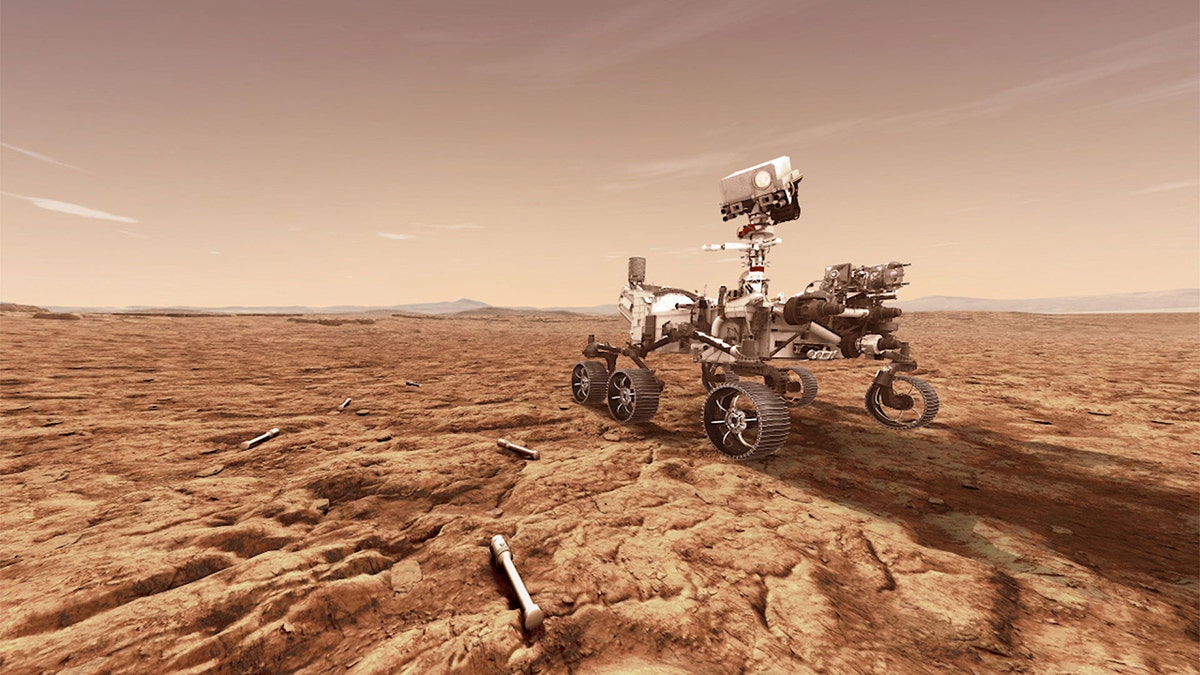
NEWYou can now listen to Fox News articles!
NASA’s Perseverance rover may have stumbled on a visitor from outer space – a strange, shiny rock on Mars that scientists think could be a meteorite forged in the heart of an ancient asteroid.
According to a new blog post on the rover’s mission page, the rock – nicknamed “Phippsaksla” – stood out from the flat, broken terrain around it, prompting NASA scientists to take a closer look.
Tests revealed high levels of iron and nickel, the same elements found in meteorites that have crashed onto both Mars and Earth.
While this isn’t the first time a rover has spotted a metallic rock on Mars, it could be the first for Perseverance. Earlier missions – including Curiosity, Opportunity, and Spirit – discovered iron-nickel meteorites scattered across the Martian surface, making it all the more surprising that Perseverance hadn’t seen one until now, NASA said.
MASSIVE ASTEROID BIGGER THAN A SKYSCRAPER HEADING TOWARD EARTH AT 24,000 MPH

NASA’s Perseverance rover discovered a shiny metallic rock that scientists believe could be a meteorite forged in the heart of an ancient asteroid. (NASA via Getty Images)
Now, just beyond the crater’s rim, the rover may have finally found one – a metallic rock perched on ancient impact-formed bedrock. If confirmed, the discovery would place Perseverance alongside the other Mars rovers that have examined fragments of cosmic visitors to the red planet.
To learn more about the rock, the team aimed Perseverance’s SuperCam – an instrument that fires a laser to analyze a target’s chemical makeup – at Phippsaksla. The readings showed unusually high levels of iron and nickel, a combination NASA said strongly suggests a meteorite origin.
Mounted atop the rover’s mast, SuperCam uses its laser to vaporize tiny bits of material, so sensors can detect the elements inside from several meters away.
SCIENTISTS SPOT SKYSCRAPER-SIZED ASTEROID RACING THROUGH SOLAR SYSTEM

The shiny rock nicknamed “Phippsaksla,” discovered by NASA’s Perseverance rover, showed high levels of iron and nickel consistent with meteorites found on Mars and Earth. (NASA)
The finding is significant, NASA noted, because iron and nickel are typically found together only in meteorites formed deep within ancient asteroids – not in native Martian rocks.
If confirmed, Phippsaksla would join a long list of meteorites identified by earlier missions, including Curiosity’s “Lebanon” and “Cacao” finds, as well as metallic fragments spotted by Opportunity and Spirit. NASA said each discovery has helped scientists better understand how meteorites interact with the Martian surface over time.
Because Phippsaksla sits atop impact-formed bedrock outside Jezero crater, NASA scientists said its location could offer clues about how the rock formed and how it ended up there.
MASSIVE COMET ZOOMING THROUGH SOLAR SYSTEM COULD BE ALIEN TECHNOLOGY, HARVARD ASTROPHYSICIST SAYS

NASA scientists say the metallic rock spotted by Perseverance may be a meteorite formed deep within an ancient asteroid before crashing onto Mars. (NASA)
For now, the agency said its team is continuing to study Phippsaksla’s unusual makeup to confirm whether it truly came from beyond Mars.
If proven to be a meteorite, the find would mark a long-awaited milestone for Perseverance – and another reminder that even on a planet 140 million miles away, there are still surprises waiting in the dust.
Perseverance, NASA’s most advanced robot to date, traveled 293 million miles to reach Mars after launching on a United Launch Alliance Atlas V rocket from Cape Canaveral Space Station in Florida on July 30, 2020. It touched down in Jezero crater on Feb. 18, 2021, where it has spent nearly four years searching for signs of ancient microbial life and exploring the planet’s surface.
CLICK HERE TO DOWNLOAD THE FOX NEWS APP
Built at NASA’s Jet Propulsion Laboratory in Pasadena, California, the $2.7 billion rover is about 10 feet long, 9 feet wide, and 7 feet tall – roughly 278 pounds heavier than its predecessor, Curiosity.
Powered by a plutonium generator, Perseverance carries seven scientific instruments, a seven-foot robotic arm, and a rock drill that allows it to collect samples that could one day return to Earth.
The mission will also help NASA prepare for future human exploration of Mars in the 2030s.
Subscribe to George Magazine and unlock exclusive bonuses. Your subscription now includes a free crypto essentials guide and three premium downloadable images. These images are perfect for personal use as desktop or mobile backgrounds, with thumbnail previews shown below.




Discount Applied Successfully!
Your savings have been added to the cart.